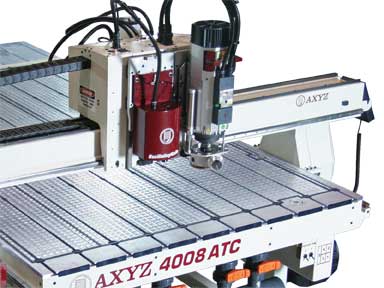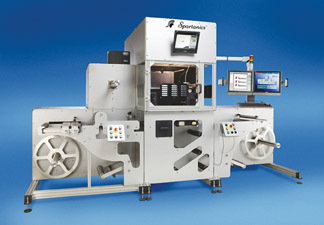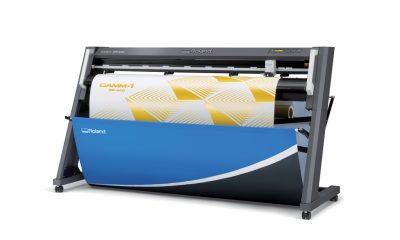Graphics Printing
Published
14 years agoon

Flatbed cutting tables are designed to give graphics specialists the ability to finish prints on a wide range of materials quickly and accurately in a variety of ways. These systems, also referred to as digital cutting tables, are engineered to handle run lengths from one piece to mass quantities and can accommodate prints produced on screen presses, inkjet printers, and other equipment.
Flatbed cutting tables are designed to give graphics specialists the ability to finish prints on a wide range of materials quickly and accurately in a variety of ways. These systems, also referred to as digital cutting tables, are engineered to handle run lengths from one piece to mass quantities and can accommodate prints produced on screen presses, inkjet printers, and other equipment.
This overview highlights of some of the flatbed cutting tables on the market. Among the key features listed are bed size, material holddown, tooling options, and speed. Let’s examine each briefly.
Generally speaking, the larger the bed size, the larger the work area (the space in which the printed substrate is ultimately placed for finishing). Material holddown refers to the way in which materials are secured to the work area. Vacuum is commonly used to keep substrates in place, though some models call for electrostatic adhesion. Some manufacturers offer zoned beds with independent vacuum pumps to facilitate finishing several prints or different jobs at once.
Tooling comes in the form of kiss-cutters, tangential knives, oscillating knives, creasing attachments, routers, fixed blades, pen plotters, drag knives, and more. Each is engineered to accomplish certain tasks or process particular materials. Some digital cutting tables also feature optical registration systems that read fiducials (printed targets) on substrates and automatically compensate for skew and distortion. A system’s operating or cutting speed typically refers to the fastest rate at which the tool head moves while at work.
You have plenty of options from which to choose when selecting a flatbed cutting table. Be sure to consult with manufacturers about the kind of materials you intend to finish so that you select a system that has the tools and other performance specifications that meet your requirements.
AXYZ International
CNC knife systems from AXYZ International can be equipped with different styles of cutting heads for processing substrates such as foam boards, closed-cell foam, plastic-covered foam, corrugated cardboard and plastic, rubber, cork, carpet, felt, single-ply fabrics, and more. The oscillating knife with tangential control is designed to provide highly accurate cutting of a variety of semi-rigid materials, including thicker media, without excessive over cut. The oscillating knife is available in a range of blade lengths and attack angles. The tangential knife is designed to provide accurate cutting of heavier flexible and semi-rigid materials and is engineered to allow the machine to accurately cut square corners and maintain part accuracy. The drag knife is designed to cut flexible and semi-rigid materials. It is equipped with a spring-loaded glider foot. Standard system features include vacuum-holddown-ready machine bed, open table access from all sides, and AXYZ’s A2MC machine control system. AXYZ’s Intelligent Cutting Solution, powered by i-cut, is available as an option.
Colex
The Colex Flatbed Cutter comes in two models: 4 x 8 ft and 5 x 10 ft (1.2 x 2.4 m and 1.5 x 3.0 m). Both feature one-piece welded-steel frames, work surfaces machined in place, X and Y movement driven by servomotors on gear-rack rails, Z axis that combines a ball-screw drive and servomotor, and more. The work surface is divided in zones: four for the 4 x 8-ft model and six for the 5 x 10-ft model. Each zone has its own vacuum pump controlled by individual on/off buttons on the front panel. Pump power is designed for compatibility with substrates used in wide-format printing. A 3-phase vacuum pump is available as an option. The cutter’s multi-tool head features four stations: router spindle (1050 W, 10,000-35,000 RPM), oscillating knife, fixed knife, and i-cut camera. The i-cut system is designed to enhance print-to-cut accuracy by enabling the cutting system to compensate for distortion. The knife stations accept different tool holders, such as kiss-cut and crease, and tool holders are interchangeable. Heavy-duty spindles are available as an option.
EskoArtwork
The Kongsberg i-XE10 from EskoArtwork is designed to kiss-cut and through-cut vinyl, polycarbonate, polyester, polypropylene, carton stock, single-wall corrugated material, and other substrates. It offers a 31.5 x 43.3-in. (800 x 1100-mm) work area, accepts material as large as 35.4 x 47.2 in. (900 x 1200 mm), and operates at speeds up to 52.5 in./sec (1333.5 mm/sec). The i-XE10 features rack-and-pinion X-Y drive and servo system, maximum acceleration of 1.2 G, maximum horizontal cutting power of 40.5 lbs force (18.4 kg force, 180 N) in any direction, and maximum vertical tool power of 26.5 lbs force (12 kg force, 120 N). The system’s operator console is mounted on the side of the table and includes a table-operator panel, main switch, emergency power switch, and storage space for tooling. It can hold a controller PC (optional) with a flatscreen monitor,keyboard, and mouse. The i-XE10 uses i-cut vision PRO software and includes the DynaGuard Safety System for operator and bystander protection. Optional, field-upgradable features for automation include conveyer system with a conveyer belt around the cutting table, conveyer extension with a conveyer belt around the cutting and extension table, roll-material holder, and loading/unloading equipment for sheet-fed media.
Gerber
Gerber’s M Turbo offers a table size of 103 x 148 in. (2620 x 3760 mm), supports an active cutting area of 75 x 120 in. (1900 x 3000 mm), cuts at speeds up to 30 in./sec (762 mm/sec), and accelerates at 0.5 G. Maximum tool force is 80 lbs (356 N). Its 1-kW, 1.4-HP, liquid-cooled spindle operates at 6000-50,000 RPM and is engineered to route acrylic and wood up to 0.75 in. (19 mm) thick. The M Turbo also features a 10-HP, five-zone vacuum, as well as Gerber’s M-Vision optical registration system, light-barrier safety system, PC workstation with cabinet, and Gerber OMEGA CP software. The system comes standard with a modular toolset: oscillating knife, pneumatic router, drag knife, and creasing wheel. Optional tools include reciprocating knife for foam cutting, drag knife for cutting highly abrasive substrates, tangential knife with micrometer-controlled depth adjustment, fixed-blade knife for angle cutting, and pen plotting tool. Other options include high-loft system configuration for increased cut height and an 18-HP vacuum-holddown system.
Graphtec America
The FC2250 from Graphtec America is available in three table sizes: 24 x 36 in., 47 x 36 in., and 68.5 x 36 in. (610 x 914 mm, 1194 x 914 mm, and 1740 x 914 mm). Its dual-head design supports a maximum cutting force of 1 kg, and the cutting system comes standard with Graphtec’s Auto Registration Mark Sensor. The FC2250 can process materials such as thin sheet metal, chipboard, magnetic sheets, board stock, gaskets, marking and reflective films, and more. The systems are available with electrostatic or vacuum-powered media holddown. They support a maximum cutting speed of 16 in. /sec (400 mm/sec). D-Cut software imports DXF data, and the Cutting Master plug-in facilitates the use of Adobe Illustrator with the FC2250. Interface is via RS-232C and USB 2.0. Standard accessories include a blade set, water-based fiber-tip pen, sheet-holder and height-adjustment plates, USB cable, CD-ROM with driver (Windows) and plug-in software (Windows and Mac OS), and more. Optional accessories include blades and blade holders in various sizes, fiber-tipped pens in different colors, creasing and scoring tools, and more.
Mimaki
Mimaki’s CF3 Series cutters come in two models: the CF3-1610 at 39.3 x 63 in. (998 x 1600 mm) and the CF3 1631 at 122 x 63 in. (3099 x 1600 mm). Both feature DC-servo drives on X, Y, Z, and theta and support a maximum cutting speed of 20 in./sec (508 mm/sec). A six-zone vacuum holddown is standard on both models, as are USB and RS-232C interfaces. Three cutting heads are available: the M router, designed for rigid materials; the R1 reciprocal cutter, designed for thick materials; and the TF2 tangential cutter, designed for a variety of flexible and rigid materials. Maximum cutting depths are 1.96 in. (50 mm) for the M head, 0.78 in. (20 mm) for R1 head, and 0.39 in. (10 mm) for the TF2 head. Set tools for the three heads include an endmill for the M; pen/swivel cutter, reciprocal cutter, and creasing roller/high-pressure tangential cutter for the R1; and pen/swivel cutter, tangential cutter, and high-pressure tangential cutter for the TF2. Both models feature photosensor-based detection of registration marks and come standard with Mimaki Plotter Manager software and the Fine Cut 7 plug-in for Adobe
Illustrator and CorelDRAW.
MultiCam
The Digital Express from MultiCam is available with 60 x 120-in. or 2 x 3-m (1524 x 3048-mm or 78.7 x 118-in.) vacuum tables. Its dual tangential receiver accommodates the following cartridges: oscillating knife, rotary, creasing wheel, drag knife, and kiss-cut knife, all of which support a 2-in. (51-mm) cut capacity. The Digital Express features the MultiVision digital registration system, which combines hardware and software to visually recognize registration marks and automatically compensate for skew and image distortion. It comes standard with Teknic digital AC servo drives; HSK-25 (ER-16 collet) tool holders with shank capacity up to 0.375 in./9.5 mm; 5.5-HP (4-kw), variable speed, 45,000-RPM spindle; and push-button tool release. All heads are driven by independent Z-axis servo, designed for fast changeover between machining operations.
Zünd
Zünd’s G3 allows operators to combine a variety of modules and tools for finishing printed graphics. The 1-kW router module features integrated, automatic dust extraction. The punching/notching module punches up to ten holes/sec. The universal module accepts all of the tools that are compatible with the G3, including universal cutter, kiss-cutter, electric oscillating cutter for materials up to 1 in. (25.4 mm) thick, pneumatic oscillating cutter for materials up to 2 in. (51 mm) thick, 45° bevel cutter for materials up to 0.18 in. (5 mm) thick, v-cut tool (0°, 15°, 22.5°, 30°, and 45° cut angles) for materials up to 0.63 in. (16 mm) thick, driven rotary tool for textiles and fibrous materials, creasing tool for corrugated stock and cardboard, creasing tool for cartons and plastics, universal drawing tool, and an inkjet marking system. Work tables are available in nine sizes, ranging from 52 x 63 in. (1321 x 1600 mm) to 126 x 125 in. (3200 x 3175 mm). Material-handling systems include a conveyor belt, universal and shaft-based roll-off units, and a sheet feeder. Zünd’s ICC camera system, which is designed to enhance registration, is available as an option. Other options include automatic knife/tool initialization and extension tables for loading/unloading during cutting operations.

Subscribe

Magazine
Get the most important news
and business ideas from Screenprinting Magazine.
Most Popular
-

 Case Studies2 months ago
Case Studies2 months agoHigh-Density Inks Help Specialty Printing Take Center Stage
-

 Art, Ad, or Alchemy2 months ago
Art, Ad, or Alchemy2 months agoF&I Printing Is Everywhere!
-

 Andy MacDougall2 months ago
Andy MacDougall2 months agoFunctional and Industrial Printing is EVERYWHERE!
-

 Columns3 weeks ago
Columns3 weeks ago8 Marketing Mistakes Not to Make When Promoting Your Screen Printing Services Online
-

 Editor's Note3 weeks ago
Editor's Note3 weeks agoLivin’ the High Life
-

 Marshall Atkinson3 weeks ago
Marshall Atkinson3 weeks agoHow to Create a Winning Culture in Your Screen-Printing Business
-

 Thomas Trimingham2 months ago
Thomas Trimingham2 months ago“Magic” Marketing for Screen Printing Shops
-

 Case Studies3 weeks ago
Case Studies3 weeks agoScreen Printing for Texture and Depth






